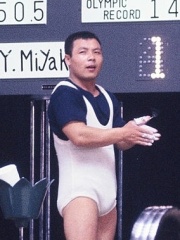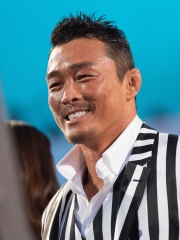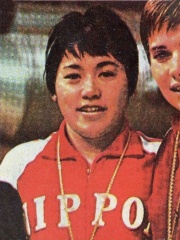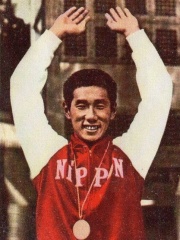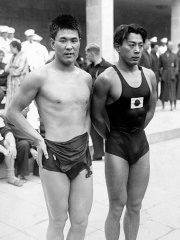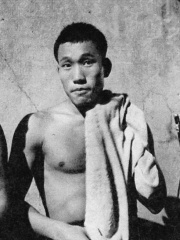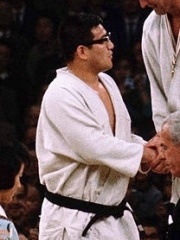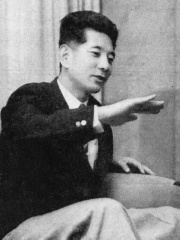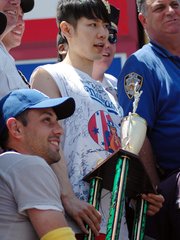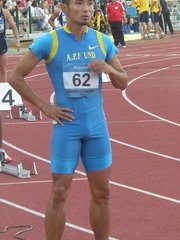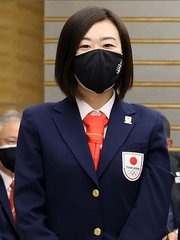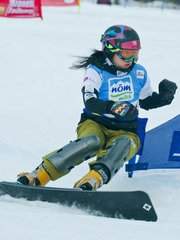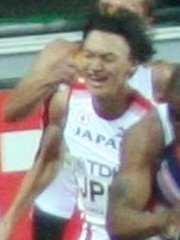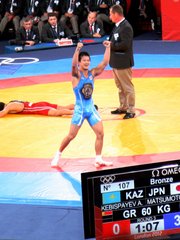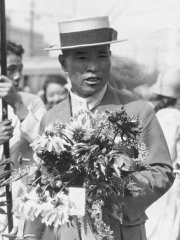
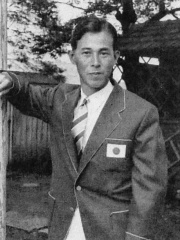
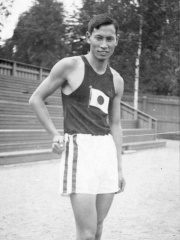
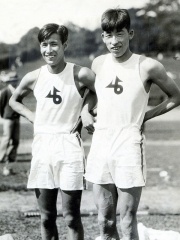
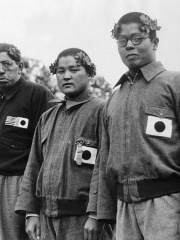
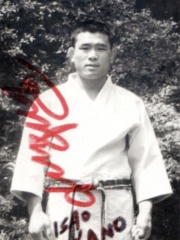
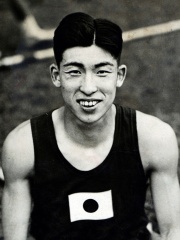
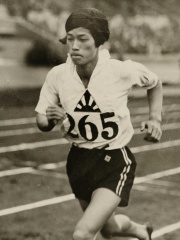
The Most Famous
ATHLETES from Japan
Top 10
The following people are considered by Pantheon to be the top 10 most legendary Japanese Athletes of all time. This list of famous Japanese Athletes is sorted by HPI (Historical Popularity Index), a metric that aggregates information on a biography's online popularity. Visit the rankings page to view the entire list of Japanese Athletes.

1. Shizo Kanakuri (1891 - 1983)
With an HPI of 62.18, Shizo Kanakuri is the most famous Japanese Athlete. His biography has been translated into 31 different languages on wikipedia.
Shizo Kanakuri (金栗 四三, Kanaguri Shisō; 20 August 1891 – 13 November 1983) was a Japanese marathon runner celebrated as the "father of marathon" in Japan. He holds the Guinness World Record for the longest time to complete a marathon with a time of 54 years 8 months 6 days 5 hours 32 minutes 20.3 seconds—Kanakuri retired from the men's marathon event at the 1912 Stockholm Olympics without informing the authorities, but Sveriges Television gave him the opportunity to complete his marathon in 1967.

2. Naoto Tajima (1912 - 1990)
With an HPI of 61.22, Naoto Tajima is the 2nd most famous Japanese Athlete. His biography has been translated into 26 different languages.
Naoto Tajima (田島 直人, Tajima Naoto; August 15, 1912 – December 4, 1990) was a Japanese athlete who competed at the 1932 and 1936 Olympics. In 1932 he finished sixth in the long jump, while in 1936 he finished third in the long jump, behind Jesse Owens and Luz Long, and won the triple jump event, setting a world record at 16.00 m. This record stood until 1951, when Adhemar da Silva improved it by one centimeter. Raised in Iwakuni, Tajima graduated in economics from Kyoto Imperial University just prior to competing in the Olympics. His gold medal was Japan's last Olympic track and field gold medal until Naoko Takahashi won the women's marathon at the 2000 Summer Olympics. Tajima retired from competitive athletics in 1938 but maintained an administrative role as managing director of the Japan Association of Athletics Federations. He was also a member of the Japanese Olympic Committee, coached the Japanese athletics teams at the 1956 and 1964 Olympics, and worked as a lecturer at Chukyo University.

3. Mikio Oda (1905 - 1998)
With an HPI of 57.32, Mikio Oda is the 3rd most famous Japanese Athlete. His biography has been translated into 27 different languages.
Mikio Oda (織田 幹雄, Oda Mikio; 30 March 1905 – 2 December 1998) was a Japanese athlete and the first Japanese Olympic gold medalist. He was the first Asian Olympic champion in an individual event.

4. Sueo Ōe (1914 - 1941)
With an HPI of 57.08, Sueo Ōe is the 4th most famous Japanese Athlete. His biography has been translated into 19 different languages.
Sueo Ōe (大江 季雄, Ōe Sueo; August 2, 1914 – December 24, 1941) was a Japanese athlete who competed mainly in the pole vault. He won a bronze medal at the 1936 Summer Olympics held in Berlin, Germany, tying with his teammate Shuhei Nishida. When the two declined to compete against each other to decide a winner, Nishida was awarded the silver after a decision of the Japanese team, on the basis that Nishida had cleared the height in fewer attempts. On their return to Japan, Nishida and Ōe had their Olympic medals cut in half, and had a jeweler splice together two new medals, half in bronze and half in silver. In 1937 Ōe set a national record at 4 m 35 cm that stood for 21 years. In 1939 he joined the Imperial Japanese Army and was killed in action in Luzon on December 24, 1941.
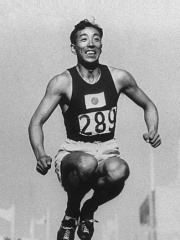
5. Chūhei Nambu (1904 - 1997)
With an HPI of 56.91, Chūhei Nambu is the 5th most famous Japanese Athlete. His biography has been translated into 23 different languages.
Chūhei Nambu (南部 忠平, Nanbu Chūhei; May 27, 1904 – July 23, 1997) was a Japanese track and field athlete. As of 2024, he is the only person to have held world records in both the long jump and the triple jump.

6. Noboru Terada (1917 - 1986)
With an HPI of 56.69, Noboru Terada is the 6th most famous Japanese Athlete. His biography has been translated into 21 different languages.
Noboru Terada (寺田 登, Terada Noboru; November 25, 1917 – September 26, 1986) was a Japanese freestyle swimmer. At the 1936 Olympics he won the gold medal in the 1500 m event with a margin of 10 seconds. In 1994 he was inducted into the International Swimming Hall of Fame.

7. Isao Okano (b. 1944)
With an HPI of 56.07, Isao Okano is the 7th most famous Japanese Athlete. His biography has been translated into 21 different languages.
Isao Okano (岡野 功, Okano Isao; born 20 January 1944) is a retired judoka who competed in the middleweight division (–80 kg) in the 1964 Summer Olympics.

8. Shuhei Nishida (1910 - 1997)
With an HPI of 55.69, Shuhei Nishida is the 8th most famous Japanese Athlete. His biography has been translated into 16 different languages.
Shuhei Nishida (西田 修平, Nishida Shūhei; March 21, 1910 – April 13, 1997) was a Japanese Olympic athlete who competed mainly in the pole vault. Nishida was born in what is now part of Nachikatsuura, Wakayama Prefecture, Japan. He was a student of the Engineering Department at Waseda University, when selected as a member of the Japanese Olympic team for the 1932 Summer Olympics in Los Angeles, where he won the silver medal in the pole vault event. After graduation from Waseda University, he obtained a job at Hitachi. He subsequently participated in the 1936 Summer Olympics held in Berlin, Germany where he repeated his performance winning a second silver medal in the same event tying with his friend and teammate Sueo Oe. When the two declined to compete against each other to decide a winner, Nishida was awarded the silver and Oe the bronze by decision of the Japanese team, on the basis that Nishida had cleared the height in fewer attempts. The competition was featured in a scene in the documentary Olympia, filmed by Leni Riefenstahl. On their return to Japan, Nishida and Oe famously had their Olympic medals cut in half, and had a jeweler splice together two new “friendship medals”, half in bronze and half in silver. At the age of 41, Nishida won a bronze medal at the 1951 Asian Games. He remained active in sports all of his life, serving as a referee at events, and from 1959 as an honorary vice chairman of the Japan Association of Athletics Federations, and as a member of the Japanese Olympic Committee. In 1989, he was awarded the silver medal of the Olympic Order. Nishida died of heart failure in 1997 at the age of 87.

9. Kinue Hitomi (1907 - 1931)
With an HPI of 55.68, Kinue Hitomi is the 9th most famous Japanese Athlete. Her biography has been translated into 22 different languages.
Kinue Hitomi (人見 絹枝, Hitomi Kinue; January 1, 1907 – August 2, 1931) was a Japanese track and field athlete. She was the world record holder in several events in the 1920s – 1930s and was the first Japanese woman to win an Olympic medal. She was also the first woman to represent Japan at the Olympics.
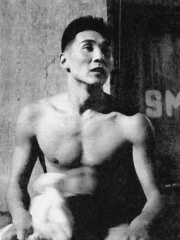
10. Hiroshi Suzuki (b. 1933)
With an HPI of 55.59, Hiroshi Suzuki is the 10th most famous Japanese Athlete. His biography has been translated into 18 different languages.
Hiroshi Suzuki (鈴木 弘, Suzuki Hiroshi; born September 18, 1933) is a retired Japanese freestyle swimmer. He competed in the 100 m and 4×200 m relay events at the 1952 and 1956 Olympics and won two silver medals in 1952. In the 100 m event in the 1952 Olympics, Hiroshi actually posted an identical time to the eventual gold medal winner, Clarke Scholes of the US. Officials used a judges decision to award Clarke Scholes the gold medal and Hiroshi Suzuki the silver medal. He won gold medals in these two events at the 1954 Asian Games.
People
Pantheon has 245 people classified as Japanese athletes born between 1891 and 2009. Of these 245, 218 (88.98%) of them are still alive today. The most famous living Japanese athletes include Isao Okano, Hiroshi Suzuki, and William Phillips. The most famous deceased Japanese athletes include Shizo Kanakuri, Naoto Tajima, and Mikio Oda. As of April 2024, 15 new Japanese athletes have been added to Pantheon including Takeru Kobayashi, Yumiko Shige, and Takahiro Sunada.
Living Japanese Athletes
Go to all RankingsIsao Okano
1944 - Present
HPI: 56.07
Hiroshi Suzuki
1933 - Present
HPI: 55.59
William Phillips
HPI: 53.72
Yoshinobu Miyake
1939 - Present
HPI: 53.31
Haruki Uemura
1951 - Present
HPI: 52.81
Yoshihiro Akiyama
1975 - Present
HPI: 52.38
Kim Eui-tae
1941 - Present
HPI: 52.33
Mayumi Aoki
1953 - Present
HPI: 51.98
Toru Goto
1934 - Present
HPI: 51.83
Shinji Hosokawa
1960 - Present
HPI: 51.45
Nobutaka Taguchi
1951 - Present
HPI: 51.45
Hideaki Tomiyama
1957 - Present
HPI: 49.22
Deceased Japanese Athletes
Go to all RankingsShizo Kanakuri
1891 - 1983
HPI: 62.18
Naoto Tajima
1912 - 1990
HPI: 61.22
Mikio Oda
1905 - 1998
HPI: 57.32
Sueo Ōe
1914 - 1941
HPI: 57.08
Chūhei Nambu
1904 - 1997
HPI: 56.91
Noboru Terada
1917 - 1986
HPI: 56.69
Shuhei Nishida
1910 - 1997
HPI: 55.69
Kinue Hitomi
1907 - 1931
HPI: 55.68
Masanori Yusa
1915 - 1975
HPI: 55.56
Masaru Furukawa
1936 - 1993
HPI: 55.48
Akio Kaminaga
1936 - 1993
HPI: 55.40
Tetsuo Hamuro
1917 - 2005
HPI: 55.40
Newly Added Japanese Athletes (2025)
Go to all RankingsTakeru Kobayashi
1978 - Present
HPI: 44.52
Yumiko Shige
1965 - 2018
HPI: 41.40
Takahiro Sunada
1973 - Present
HPI: 39.81
Dai Tamesue
1978 - Present
HPI: 39.24
Yoriko Okamoto
1971 - Present
HPI: 39.08
Kotomi Ishizaki
1979 - Present
HPI: 36.06
Tsuyoshi Ogata
1973 - Present
HPI: 35.92
Nonoka Ozaki
2003 - Present
HPI: 35.81
Chisato Fukushima
1988 - Present
HPI: 35.57
Tomoka Takeuchi
1983 - Present
HPI: 35.28
Shinji Takahira
1984 - Present
HPI: 34.68
Ryūtarō Matsumoto
1986 - Present
HPI: 34.00
Overlapping Lives
Which Athletes were alive at the same time? This visualization shows the lifespans of the 19 most globally memorable Athletes since 1700.


